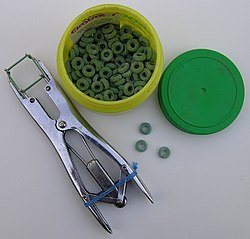
A rubber band (also known as an elastic, gum band or lacky band) is a loop of rubber, usually ring or oval shaped, and commonly used to hold multiple objects together. The rubber band was patented in England on March 17, 1845, by Stephen Perry. [1] [2] [3] Most rubber bands are manufactured out of natural rubber as well as for latex free rubber bands or, especially at larger sizes, an elastomer, and are sold in a variety of sizes.
Contents
- Manufacturing
- Rubber band sizes
- Measuring
- Size numbers
- Thermodynamics
- Red rubber bands
- Rubber bands in orthodontics
- Ranger bands
- Elastration
- Model use
- Balls
- Notable rubber band balls
- See also
- References
- External links
Notable developments in the evolution of rubber bands began in 1923 when William H. Spencer obtained a few Goodyear inner tubes and cut the bands by hand in his basement, where he founded Alliance Rubber Company. Spencer persuaded the Akron Beacon Journal as well as the Tulsa World to try wrapping their newspapers with one of his rubber bands to prevent them from blowing across lawns. He went on to pioneer other new markets for rubber bands such as: agricultural and industrial applications and a myriad of other uses. Spencer obtained a patent on February 19, 1957, for a new "Method for Making Elastic Bands" which produced rubber bands in an Open Ring design. [4]

![[?]10 Royal Mail rubber bands, on a letter size guide Royal Mail band.jpg](http://upload.wikimedia.org/wikipedia/commons/thumb/6/61/Royal_Mail_band.jpg/250px-Royal_Mail_band.jpg)




